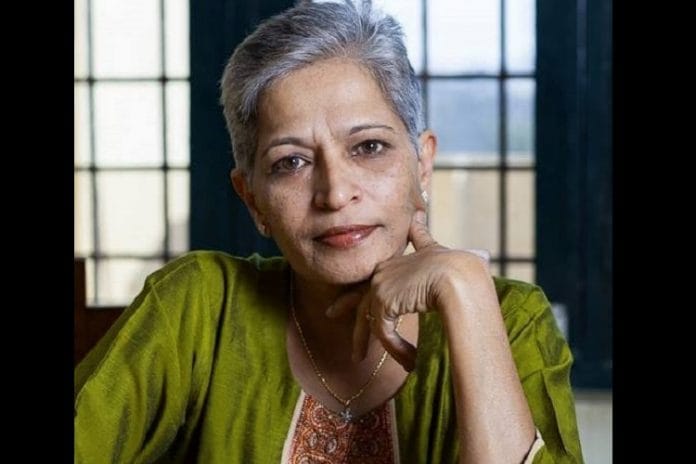
‘Illiberal India’ is an eminently readable narrative, and is as close to a biography of Gauri as there is likely to be in English.
In 10 months since Gauri Lankesh was shot dead at her doorstep in Bengaluru, the investigation hasn’t led to a conclusive answer about who killed her and why. Some arrests have been made, but like the killings of M.M. Kalburgi, Govind Pansare and Narendra Dabholkar between August 2013 and August 2015, the mystery remains unsolved.
On the other hand, the intellectual responses to these killings have been more promising. Kalburgi’s assassination, in particular, led to the ‘Award Wapsi’ movement and a robust debate on the growing intolerance in Narendra Modi’s India. A new book, Illiberal India: Gauri Lankesh and the Age of Unreason, written by veteran journalist Chidanand Rajghatta, attempts to comprehend the state of our nation and age.
Rajghatta, who was married to Gauri and remained her life-long friend, has produced an eminently readable narrative – part personal memoir and part social history of our times. He deftly combines his four-decade long personal interactions with Gauri with vignettes from contemporary cultural, intellectual and media controversies. Individual lives intersect with collective concerns seamlessly and organically, producing a superbly written narrative. Such an account, especially one that focuses on Karnataka’s public life, is rare, especially in English. Moreover, this is as close to a biography of Gauri Lankesh as one is likely to get.
An uncontrived narrative
The two key terms in the title – ‘illiberal’ and ‘unreason’ – clearly reveal Rajghatta’s reading of contemporary India. On the one hand, the increasingly vanishing traditions of liberalism, which had sprung either from modern Western liberal thought or from India’s own indigenous forms of tolerance, have created not only an intolerant but an increasingly violent India. On the other hand, the term ‘unreason’ has had a specific connotation in social theory. It was mostly used in relation to the rise of anti-semitism and fascism in Europe.
More recently, liberal thinkers (Susan Jacoby, the author of The Age of American Unreason, comes to mind) have used this term to signal a rightward turn in the liberal democracies of the West.
Despite such global and ideological linkages, Rajghatta’s narrative is neither contrived nor his analysis predetermined. The reason for that is his singular focus on a region, Karnataka, its people, and their intellectual culture. Rajghatta keeps returning to how he (and Gauri) came to understand and embrace Kannadigas and their culture.
Apart from their professional opportunities as journalists based in Bengaluru, a specific conduit in this process was Gauri’s father and Kannada writer P. Lankesh. A poet, playwright and novelist of considerable repute, Lankesh was at his most influential as a journalist. Through him, Rajghatta and Gauri entered the Kannada literary world and accessed other contemporary writers. However, as journalists working in the English media, they remained sympathetic observers. It was only after Lankesh’s death that Gauri took over her father’s weekly and immersed herself in this universe, determined to shape its future.
Changes in Kannada intellectual world
In a way, this book is primarily about how the Kannada intellectual world has changed in the last two decades, in the face of repeated onslaughts by illiberal segments of Indian society.
The values of this Kannada intellectual world had been primarily shaped by a progressive consensus produced in the 1960s by a group of socialist thinkers and writers. This consensus had advocated progressive causes such as land reforms and reservation, as well as political opportunities for OBCs, inter-caste marriages, decentralisation of power, and primacy for Kannada in administration as well as education at all levels.
Such a progressive consensus may have been an elite creation. It may not have possessed popular support among all sections of Kannada society. Yet, it influenced social movements, determined and anchored social change in Karnataka since the 1960s. It also created a radical political agenda which was implemented in the following decades by Devaraj Urs and Ramakrishna Hegde.
This progressive consensus faced a significant challenge from the rise of Hindutva forces in Karnataka. Different strands of Hindutva aggressively attacked Kannada intellectuals, primarily for their critique of Hinduism. Leading such relentless attacks were writers like S.L. Bhyrappa, pontiffs such as Shri Vishvesha Teertha Swamiji of Pejavara Matha, and politicians like Ananth Kumar Hegde, union minister and provocateur par excellence.
Quietly and fairly quickly, such attacks found much support especially among Kannada middle classes. Consequently now, ‘intellectual’ (or buddhijeevi in Kannada) has become a vituperative term, hurled at progressive writers, often triggering violence.
Rajghatta’s narrative of Karnataka and Kannadigas is perhaps the first account of the collapse of progressive consensus and the rise of intolerant, violent Hindutva in this region. In the last decade and a half of her life, Gauri Lankesh became one of the principal protagonists of this struggle. She vehemently opposed Hindutva’s social projects in the Western Ghats and coastal Karnataka; tried to bring Naxals into the mainstream; took part in ecological and social justice struggles, and kept the spirit of progressive thought alive through her newspaper. Her activism cost her life.
Through this book, we can begin to understand her life and death, and also the changes that Karnataka has seen in the past two decades.
Prithvi Datta Chandra Shobhi is a social historian and political commentator.


COMMENTS